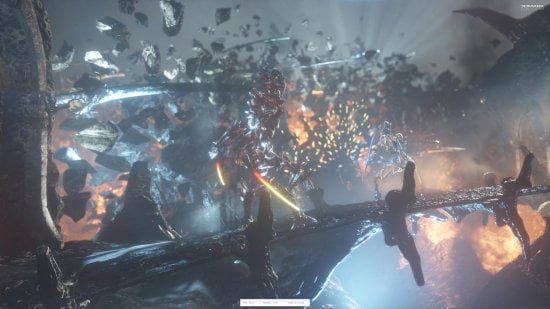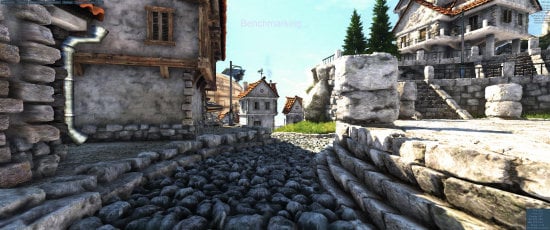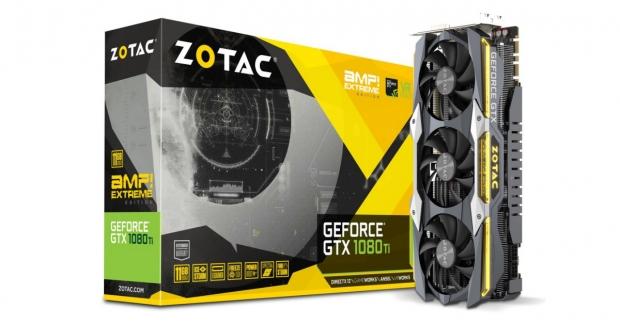
The Bottom Line
Introduction & Specs
ZOTAC is always one of the companies I look to when a new series of GeForce graphics cards come out, so when NVIDIA revealed the GeForce GTX 1080 Ti last month - ZOTAC were the first brand that came to mind. Fast forward a few weeks, and a couple of custom GeForce GTX 1080 Ti cards under my belt, the ZOTAC GeForce GTX 1080 Ti AMP! Extreme Edition is now in my hands.
Specifications
ZOTAC's fastest graphics card range is the AMP! Extreme Edition, so the clocks on the GTX 1080 Ti AMP! Extreme Edition are already quite high - and we have seen it boost at 2GHz, and stable at 2050MHz with some major overclocks to the GDDR5X. For now, here are the official product specifications:
ZOTAC has the GTX 1080 Ti AMP! Extreme Edition clocked at 1645/1759MHz base and boost, but thanks to GPU Boost 3.0, it was hitting 1950-1975MHz. We'll have a follow-up piece soon with our overclocks on the GTX 1080 Ti AMP! Extreme Edition, which I cranked the GDDR5X up from 11.2GHz to 12GHz - giving us some huge improvements in our new 4K, 5K and 8K benchmarks.
There are four different models of GeForce GTX 1080 Ti graphics cards in ZOTAC's arsenal, led by the GTX 1080 Ti AMP! Extreme Edition, and the GTX 1080 Ti AMP! Edition. There's the GeForce GTX 1080 Ti BLOWER, with a blower-style fan, and then the ZOTAC GeForce GTX 1080 Ti Founders Edition.
Cooling Tech
NVIDIA provides the best consumer graphics card you can buy with its stock GeForce GTX 1080 Ti, but ZOTAC uses a custom PCB, one of the best cooling solutions made for a graphics card, and overclocks to both the GPU and GDDR5X RAM.
It really is the best of both worlds, as ZOTAC is one of the best AIB partners for NVIDIA when it comes to high-end graphics cards.
ZOTAC spends considerable time on the design of the card, with the company touting that the card is "significantly tuned to achieve supercar-like performance and thoroughly tested for system stability in the hardest of environments."
SPECTRA has been upgraded on the new GTX 1080 Ti AMP! Extreme Edition, with new lighting modes and a much wider color spectrum that can be tuned from ZOTAC's own FireStorm software. There are now three different color zones that light up, which look awesome in dark environments. Each of them can be controlled individually through FireStorm, too.
ZOTAC has a specific design with its AMP! graphics cards and I'm really digging it. Not so much with the now-forced 'GEFORCE GTX' branding at the top.
When it comes to cooling, ZOTAC is king - at 2GHz and 12GHz for the GPU and GDDR5X, respectively - our card was hitting 67C maximum with the fans barely making any noise at all.
This is all thanks to ZOTAC's cooling technology, IceStorm.
When the GTX 1080 Ti AMP! Extreme Edition is idle, or in low GPU usage - the fans won't turn on thanks to ZOTAC's Freeze technology.
Another area where ZOTAC spends engineering brain time is on the custom PCB and power delivery on the GTX 1080 Ti AMP! Extreme Edition, with their Power Boost technology - a control chip on the board itself which provides live electrical current regulation and instant electrical deviation responses.
It's an impressive piece of technology, which also reduces ripple noise, minimizes power fluctuation, and has a high-temperature tolerance. This lets you enjoy piece of mind, as your ZOTAC GeForce GTX 1080 Ti AMP! Extreme Edition will last longer, especially with those constant games you'll be playing, right?
Detailed Look
ZOTAC's range of AMP! graphics cards have always had a distinct look, and while it's a chunky card - the heft is worth it. Under complete 100% load, and even with the 11GB of GDDR5X RAM clocked up from 11.2GHz to 12GHz, the card maxes out at 67C.
ZOTAC's new GeForce GTX 1080 Ti AMP! Extreme Edition looks awesome from the top, but you'll notice all of the custom GTX 1080 Ti graphics cards now have 'GEFORCE GTX' branding on them. Don't believe me?
Assisted by some Philips Hue LED strip lighting, the card looks awesome.
Test System Specs & Benchmark Details
Test System Specifications
I've recently edited my GPU test bed, which was powered by the Intel Core i7-5960X processor, and shifted into the arms of Kaby Lake and Intel's new Core i7-7700K. GIGABYTE hooked us up with their awesome new AORUS Z270X-Gaming 9 motherboard, which is the heart and soul of my new GPU test platform.
Detailed Tech Specs
- CPU: Intel Core i7-7700K
- Cooler: Nocua U12S
- MB: AORUS Z270X-Gaming 9
- RAM: 16GB (2x8GB) G.SKILL Trident Z 4000MHz DDR4
- SSD: 1TB OCZ RD400 NVMe M.2
- PSU: Corsair AX1500i
- Chassis: In Win X-Frame
Detailed Look
There's a bigger article I've got coming that will detail the new system, but for now - here are some shots I've taken of the new system in action:
What Resolutions We Are Testing
I've run through Unigine's new Superposition on a bunch of different resolutions, bringing every single graphics card - even overclocked GeForce GTX 1080 Ti graphics card, to their knees.
- 1080p (1920x1080)
- 1440p (2560x1440)
- 4K (3840x2160)
- UW (3440x1440)
- 5K (5120x2880)
- 8K (7680x4320)
Benchmarks - Synthetic
3DMark Fire Strike - 1080p

3DMark has been a staple benchmark for years now, all the way back to when The Matrix was released and Futuremark had bullet time inspired benchmarks. 3DMark is the perfect tool to see if your system - most important, your CPU and GPU - is performing as it should. You can search results for your GPU, to see if it falls in line with other systems based on similar hardware.
3DMark Fire Strike - 1440p
3DMark has been a staple benchmark for years now, all the way back to when The Matrix was released and Futuremark had bullet time inspired benchmarks. 3DMark is the perfect tool to see if your system - most important, your CPU and GPU - is performing as it should. You can search results for your GPU, to see if it falls in line with other systems based on similar hardware.
3DMark Fire Strike - 4K
3DMark has been a staple benchmark for years now, all the way back to when The Matrix was released and Futuremark had bullet time inspired benchmarks. 3DMark is the perfect tool to see if your system - most important, your CPU and GPU - is performing as it should. You can search results for your GPU, to see if it falls in line with other systems based on similar hardware.
Heaven - 1080p

Heaven is an intensive GPU benchmark that really pushes your silicon to its limits. It's another favorite of ours as it has some great scaling for multi-GPU testing, and it's great for getting your GPU to 100% for power and noise testing.
Heaven - 1440p
Heaven - 4K
Heaven - 3440x1440
Benchmarks - 1080p
1080p Benchmarks
Ubisoft's latest installment in the Tom Clancy's Ghost Recon series is Ghost Recon Wildlands, an open world tactical shooter with some of the best graphics on the market, with Ubisoft Paris using a modified version of the AnvilNext engine.
Rise of the Tomb Raider is one of the best looking games on the market, a truly gorgeous game - and a wonder to benchmark. The team at Crystal Dynamics made a very scalable PC game that plays really well testing graphics cards. We've got DX11 and DX12 results in one here, showing the slight strengths of running DX12 mode.
Far Cry Primal is a game built on the impressive Dunia Engine 2 with wide open, beautiful environments. It might look stunning, but the performance is actually quite good - but most cards will be stressed at 1440p, and especially so at 4K and beyond.
You can buy Far Cry Primal at Amazon.
Middle-earth: Shadow of Mordor is one of the most graphically intensive games we test, with Monolith using their own Lithtech engine to power the game. When cranked up to maximum detail, it will chew through your GPU and its VRAM like it's nothing.
You can buy Middle-earth: Shadow of Mordor at Amazon.
Metro: Last Light Redux comes from developer 4A Games, making the Redux version of Metro: Last Light the 'definitive' version of the game. Redux had a fresh coat of paint on the already impressive 4A Engine, and it really pushes our GPUs to their limits.
You can buy Metro: Last Light Redux at Amazon.
Benchmarks - 1440p
1440p Benchmarks
Ubisoft's latest installment in the Tom Clancy's Ghost Recon series is Ghost Recon Wildlands, an open world tactical shooter with some of the best graphics on the market, with Ubisoft Paris using a modified version of the AnvilNext engine.
Rise of the Tomb Raider is one of the best looking games on the market, a truly gorgeous game - and a wonder to benchmark. The team at Crystal Dynamics made a very scalable PC game that plays really well testing graphics cards. We've got DX11 and DX12 results in one here, showing the slight strengths of running DX12 mode.
Far Cry Primal is a game built on the impressive Dunia Engine 2 with wide open, beautiful environments. It might look stunning, but the performance is actually quite good - but most cards will be stressed at 1440p, and especially so at 4K and beyond.
You can buy Far Cry Primal at Amazon.
Middle-earth: Shadow of Mordor is one of the most graphically intensive games we test, with Monolith using their own Lithtech engine to power the game. When cranked up to maximum detail, it will chew through your GPU and its VRAM like it's nothing.
You can buy Middle-earth: Shadow of Mordor at Amazon.
Metro: Last Light Redux comes from developer 4A Games, making the Redux version of Metro: Last Light the 'definitive' version of the game. Redux had a fresh coat of paint on the already impressive 4A Engine, and it really pushes our GPUs to their limits.
You can buy Metro: Last Light Redux at Amazon.
Benchmarks - 3440x1440
3440x1440 Benchmarks
Ubisoft's latest installment in the Tom Clancy's Ghost Recon series is Ghost Recon Wildlands, an open world tactical shooter with some of the best graphics on the market, with Ubisoft Paris using a modified version of the AnvilNext engine.
Rise of the Tomb Raider is one of the best looking games on the market, a truly gorgeous game - and a wonder to benchmark. The team at Crystal Dynamics made a very scalable PC game that plays really well testing graphics cards. We've got DX11 and DX12 results in one here, showing the slight strengths of running DX12 mode.
Far Cry Primal is a game built on the impressive Dunia Engine 2 with wide open, beautiful environments. It might look stunning, but the performance is actually quite good - but most cards will be stressed at 1440p, and especially so at 4K and beyond.
You can buy Far Cry Primal at Amazon.
Middle-earth: Shadow of Mordor is one of the most graphically intensive games we test, with Monolith using their own Lithtech engine to power the game. When cranked up to maximum detail, it will chew through your GPU and its VRAM like it's nothing.
You can buy Middle-earth: Shadow of Mordor at Amazon.
Metro: Last Light Redux comes from developer 4A Games, making the Redux version of Metro: Last Light the 'definitive' version of the game. Redux had a fresh coat of paint on the already impressive 4A Engine, and it really pushes our GPUs to their limits.
You can buy Metro: Last Light Redux at Amazon.
Benchmarks - 4K
4K Benchmarks
Ubisoft's latest installment in the Tom Clancy's Ghost Recon series is Ghost Recon Wildlands, an open world tactical shooter with some of the best graphics on the market, with Ubisoft Paris using a modified version of the AnvilNext engine.
Rise of the Tomb Raider is one of the best looking games on the market, a truly gorgeous game - and a wonder to benchmark. The team at Crystal Dynamics made a very scalable PC game that plays really well testing graphics cards. We've got DX11 and DX12 results in one here, showing the slight strengths of running DX12 mode.
Far Cry Primal is a game built on the impressive Dunia Engine 2 with wide open, beautiful environments. It might look stunning, but the performance is actually quite good - but most cards will be stressed at 1440p, and especially so at 4K and beyond.
You can buy Far Cry Primal at Amazon.
Middle-earth: Shadow of Mordor is one of the most graphically intensive games we test, with Monolith using their own Lithtech engine to power the game. When cranked up to maximum detail, it will chew through your GPU and its VRAM like it's nothing.
You can buy Middle-earth: Shadow of Mordor at Amazon.
Metro: Last Light Redux comes from developer 4A Games, making the Redux version of Metro: Last Light the 'definitive' version of the game. Redux had a fresh coat of paint on the already impressive 4A Engine, and it really pushes our GPUs to their limits.
You can buy Metro: Last Light Redux at Amazon.
Benchmarks - 5K
Benchmarks - 8K
Temps, Power & Overclocking
Temps & Power
At full load on our Core i7-7700K/GIGABYTE Z270X-Gaming 9 combo, the ZOTAC GeForce GTX 1080 Ti AMP! Extreme Edition hit a maximum of 67C, while the entire PC consumed 370W at load.
Overclocking
ZOTAC has its GeForce GTX 1080 Ti AMP! Extreme Edition listed at 1759MHz GPU boost, but our sample was hitting 1950MHz and could overclock through to 2100MHz in some benchmarks - but crashed, and in others, it was at 2050MHz stable.
But it was the 11GB of already-overclocked GDDR5X RAM that I was surprised with, as I was able to bump it from its 11.2GHz overclocked speed - to 12GHz. The 12Gbps of bandwidth on the 11GB of GDDR5X scales incredibly well on memory bandwidth starved situations, like our new Unigine Superposition benchmark.
We are now using this as our new benchmark and will be testing it extensively over the coming months with multiple systems worth of testing already done across 10+ graphics cards, we have some big content coming on Superposition.
Superposition makes great use of the massive 527.9GB/sec of memory bandwidth I was able to achieve out of the ZOTAC GeForce GTX 1080 Ti AMP! Extreme Edition at 12GHz.
Final Thoughts
ZOTAC, you've done it again: you've mastered the GeForce GTX 1080 Ti with the best GTX 1080 Ti that I've tested so far. In my arsenal, is the AORUS GeForce GTX 1080 Ti 11G, the awesome MSI GeForce GTX 1080 Ti Gaming X 11G, and the ASUS GeForce GTX 1080 Ti Strix OC.
ZOTAC's new GeForce GTX 1080 Ti AMP! Extreme Edition has enough power to win against all of the custom GTX 1080 Ti cards I've tested so far, and especially in 4K - and our new 5K and 8K benchmarks. In the memory bandwidth starved testing that I've discovered in Unigine's new Superposition benchmark, the overclocked 11GB of GDDR5X on the ZOTAC GTX 1080 Ti AMP! Extreme Edition really comes into play.
I wasn't able to get the GPU past 2075MHz or so, but the GDDR5X clocked from its overclocked setting of 11.2GHz, to 12GHz - resulting in a huge 527.9GB/sec of memory bandwidth. Considering that HBM1 on the AMD Radeon R9 Fury X had 512GB/sec and the new GTX 1080 Ti has 480GB/sec - 527.9GB/sec is a massive achievement. It helps memory bandwidth starved benchmarks in 5K and 8K, which kinda blew my mind. Bring on HBM2 and the Radeon RX Vega in Superposition - but until then, ZOTAC has the Superposition benchmark champion award with the GTX 1080 Ti AMP! Extreme Edition.
If you want the fastest graphics card known to man, it's right here: ZOTAC's GeForce GTX 1080 Ti AMP! Extreme Edition - ready for gaming now, and in the future.






























































